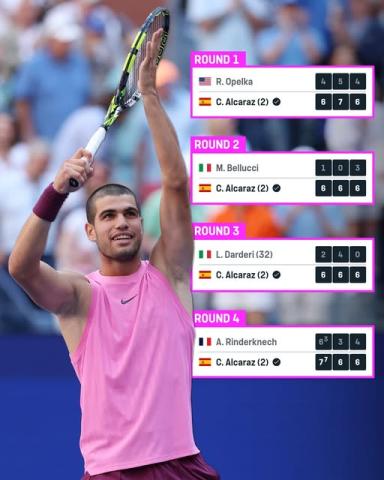
New York, NY – The scoreboard tells one story: a dominant 6-3, 6-3, 6-4 victory over a formidable opponent. But the story of Carlos Alcaraz’s relentless march into the US Open quarterfinals without dropping a single set is written not in the numbers, but in the mind. This isn't just a display of breathtaking power and jaw-dropping shot-making; it's a masterclass in the mental habits of a champion who operates two steps ahead of everyone else.
The Habit: Anticipating the Inevitable
While other players react, Carlos Alcaraz anticipates. This is the cornerstone of his mental habit—a deep, almost preternatural reading of the game that makes his violent shot-making possible. He doesn't just see where the ball is; he sees where it will be, and more importantly, where his opponent will be after they hit it.
This habit of anticipation manifests in several key ways:
-
Reading the Serve: Before an opponent even tosses the ball, Alcaraz is processing a myriad of cues—their ball toss placement, shoulder angle, and body weight. This allows him to start his return movement a fraction of a second earlier, transforming a defensive shot into an aggressive start to a rally.
-
Predicting Patterns: Alcaraz doesn't just play the ball; he plays the player. He quickly identifies and locks into his opponent's preferred patterns—the run-around forehand, the bail-out slice, the desperate lob. By the middle of the first set, he is already moving to where he knows the ball is going to land, cutting off angles and shrinking the court.
-
The Chess Master's Gambit: Many of his most spectacular shots—the drop volley, the sudden down-the-line bullet—are not just acts of improvisation. They are the result of a calculated plan to pull his opponent into a vulnerable position, knowing exactly which part of the court he will expose for a winner on the next shot.
Game Analysis: Why He is Always Winning
His straight-set run is no accident. It's the product of this anticipatory habit crushing opponents both physically and psychologically.
-
Short Points, Fresh Legs: By taking the ball so early and dictating play, Alcaraz ends points quickly. He avoids the draining, elongated rallies that sap energy over a two-week tournament. This is why he looks as fresh in the third set as he did in the first, a terrifying prospect for any opponent.
-
The Demoralization Effect: Imagine hitting what you believe is a perfect, 100-mph winner, only to see Alcaraz not only get there but fire it back with interest. This is psychologically devastating. Opponents feel they have no safe haven, no reliable shot. Their game plan disintegrates because Alcaraz’s anticipation systematically dismantles it, piece by piece.
-
Control of the "T": Alcaraz owns the center of the court. His habit of stepping inside the baseline allows him to take time away from his rivals, treating every shot, even returns of serve, as opportunities to attack. He turns the tennis court from a 78-foot rectangle into a suffocatingly small box.
More Than Just Physicality
It's easy to attribute Alcaraz's success to his explosive speed and powerful forehand. But those are merely the tools. The true engine is his mind. His mental habit of anticipation is what allows his physical gifts to flourish. He isn't just faster; he starts faster because he has already decoded the play.
As he moves into the quarterfinals, the competition will get tougher. The opponents will hit harder and try to disrupt his rhythm. But Carlos Alcaraz’s greatest weapon isn't for sale or for copy. It's the hardwired habit of a generational talent who doesn't wait for the game to come to him. He steps forward, into the future of the point, and meets it head-on. For anyone standing across the net, that is the most daunting prospect of all.
